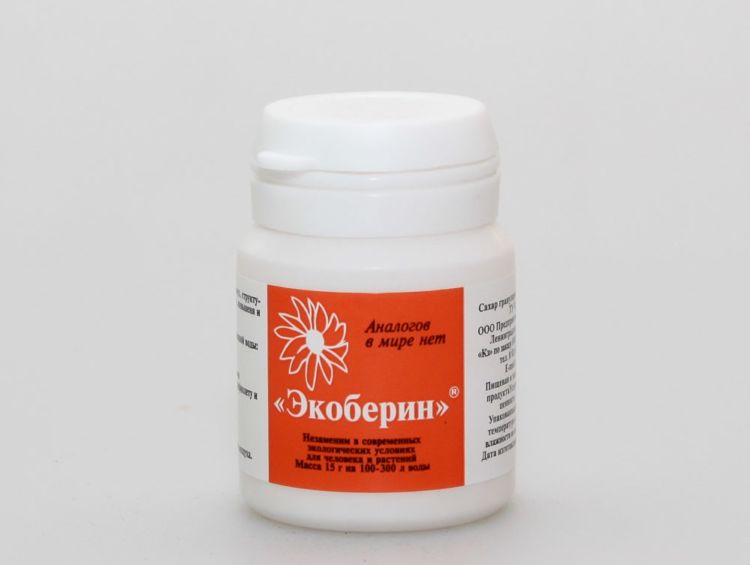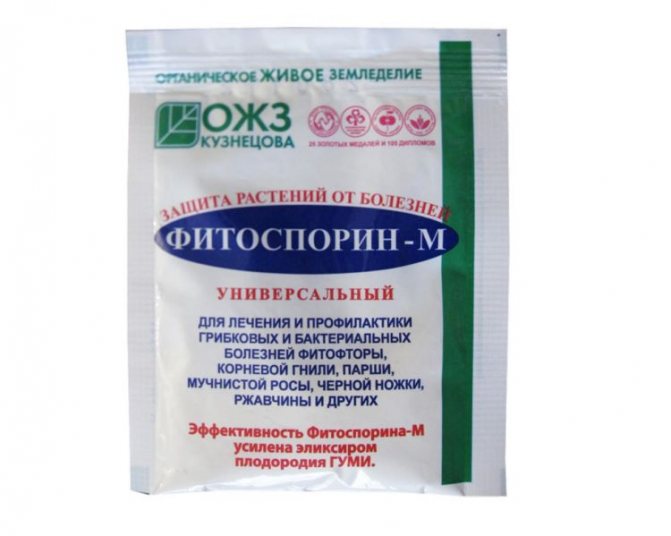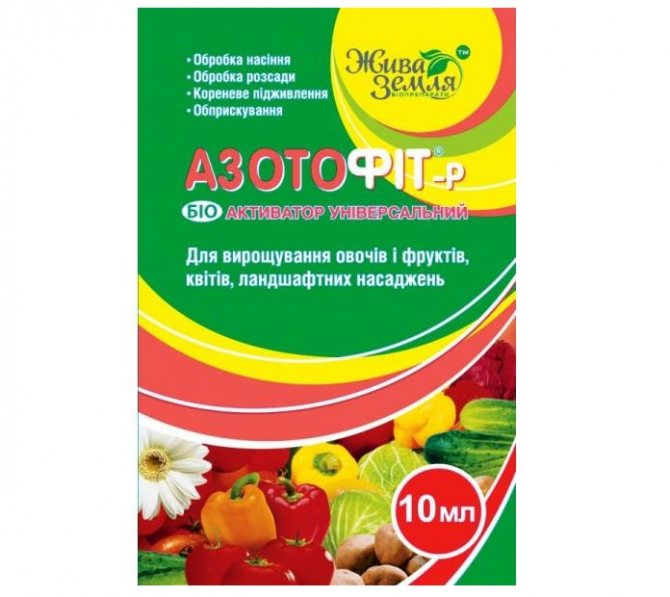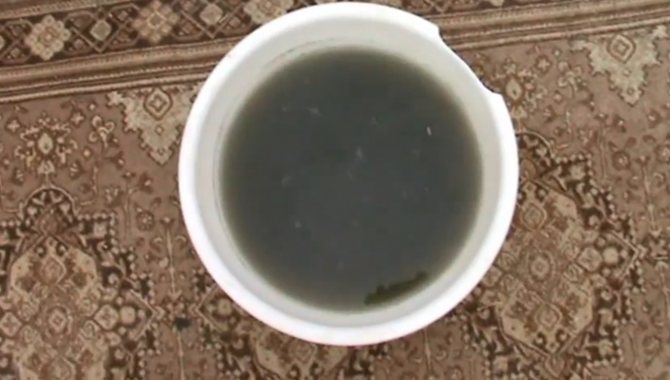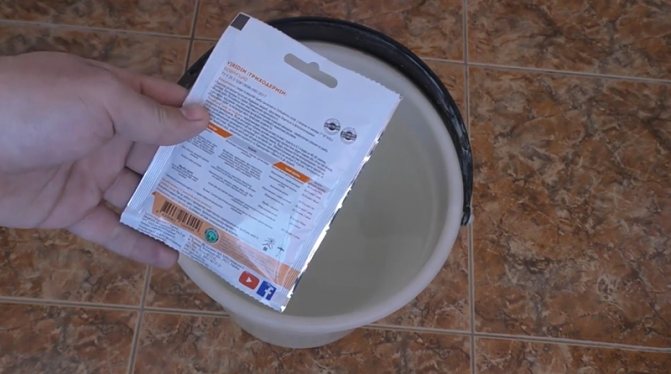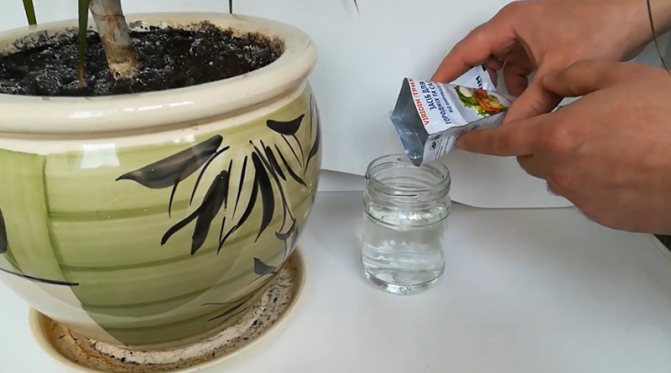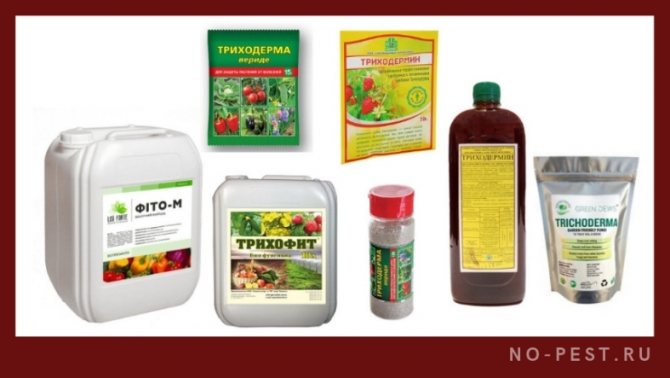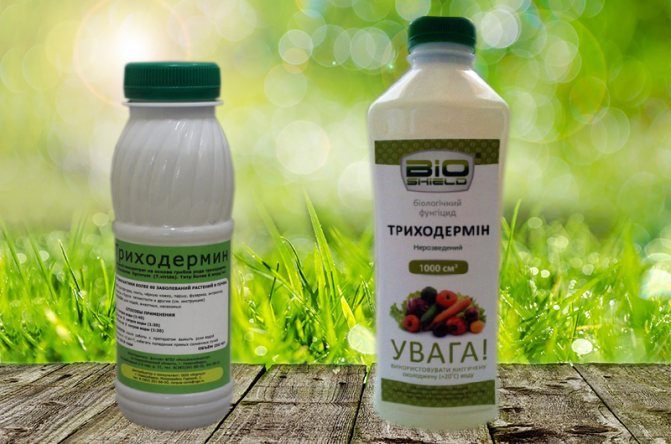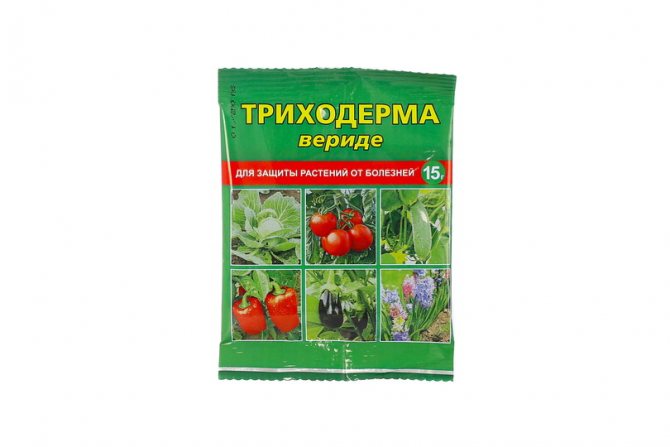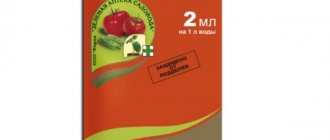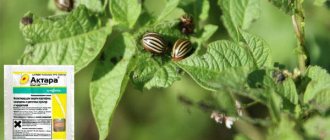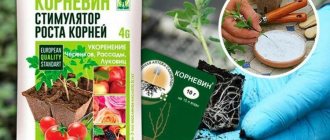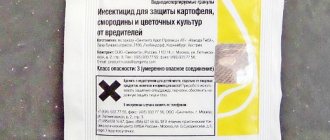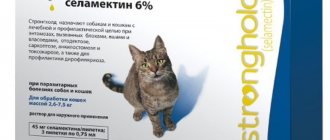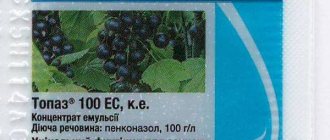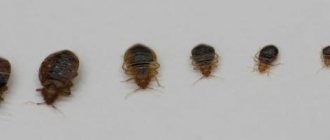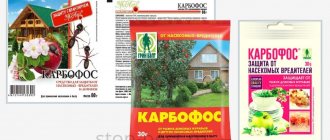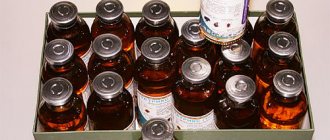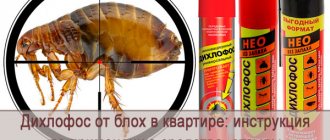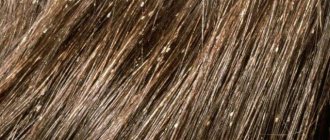Fitosporin
Microbiological preparation effective against fungal and bacterial diseases of any culture.
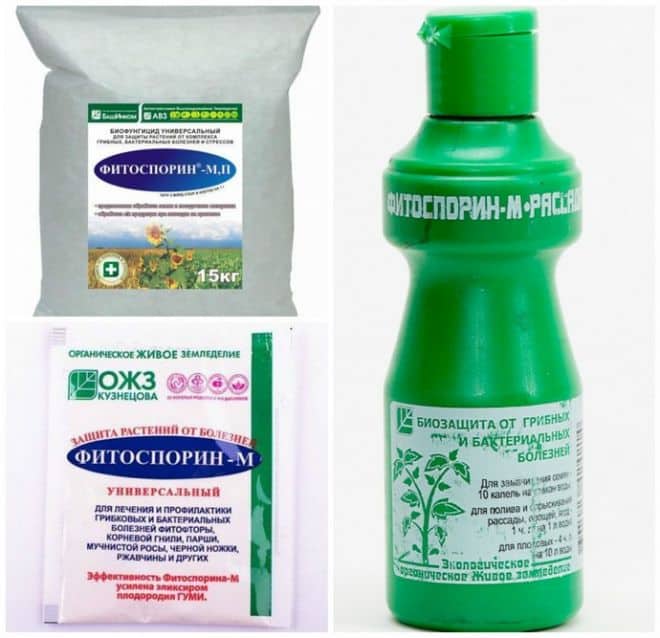
Structure
- The main component is the bacteria Bacilus Subtilis;
- In some brands there is a bioadditive "Gumi", consisting of humic acid, brown coal and macronutrients.
Storage conditions
The shelf life is four years. Store Fitosporin in a dry place inaccessible to children and animals with temperatures ranging from -20 to +30 degrees Celsius.
Appointment
- Treatment of plants for bacterial and fungal diseases;
- Spraying crops during flowering;
- Seed treatment.
Operating principle
After processing, microorganisms begin to actively feed, and their excretory processes are accelerated. Metabolic products have a detrimental effect on fungi, and the process of their reproduction is inhibited. Since, thanks to the drug, the immunity of the plant culture is strengthened, the likelihood of re-infection is close to zero.
It should be noted that the action of phytosporin is not capable of harming plantings and does not cause allergies or poisoning in humans.
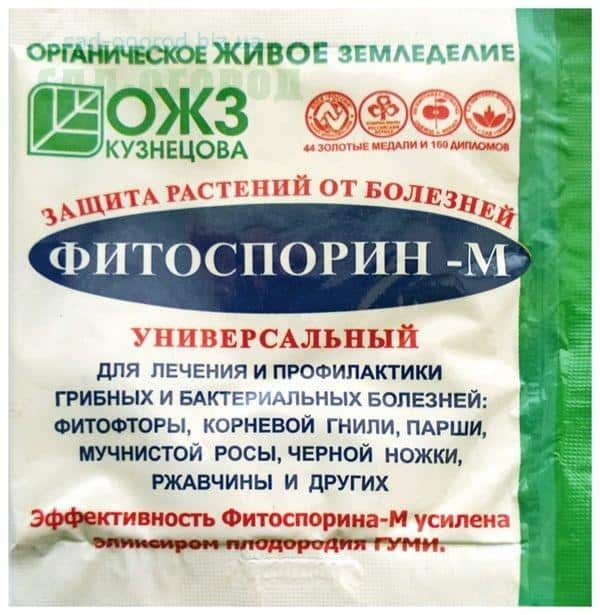

Recommendations and conclusions
- The safety of the drugs "Trichodermin" and Trichoderma Veride "is not disputed - they are not toxic and completely safe for humans.
- The storage conditions of the preparations should be observed - store in a dry and cool place.
- Unlike the well-known drug "Fitosporin", these drugs do not affect the cellular structure of plants, however, "Trichodermin" has a faster effect of its action. For maximum efficiency, they can be used together.
- The obvious advantages (2in1) are, firstly, effective prevention and treatment of fungal diseases, and secondly, the improvement and saturation of the soil.
- I definitely recommend Trichodermin for use.
*** Changes and additions were made on 09/05/2019.
Comparison of Trichodermin and Fitosporin
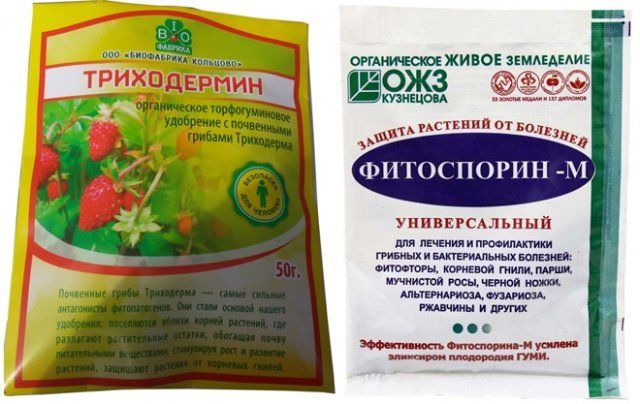

The manufacturers of these insecticides claim that the main difference between them is the speed of action.
Fitosporin is based on a special spore culture, which, due to its vital processes, displaces and also suppresses the appearance and reproduction of various fungal and bacterial diseases.
Trichodermin, due to its composition, begins to fight and destroy pathogenic microorganisms much faster. But Phytosporin spreads much more slowly, but penetrates into the plant, due to which it can destroy various diseases from the inside. In addition, this particular insecticide is often used to store fruits and plant bulbs.
Thus, each of these drugs has its own benefits. Trichodermine acts faster and has a longer lasting effect. But its competitor is able to cope with a number of other diseases, but the process itself takes longer.
Use of the drug for soil disinfection
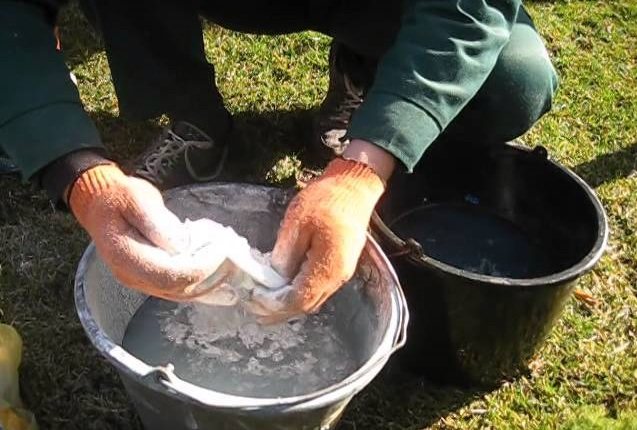

Even a novice gardener will be able to independently prepare a working solution from Trichodermin, which will help increase the yield of crops grown. It is only necessary to dilute 6 liters of the preparation in 100 liters of pure water. The funds received will be enough for 1 ton of compost. To achieve a better result, it is better to leave the solution in a dark place for 60 days for full ripening.
It is possible to increase soil fertility due to timely fertilization with a rotted mass, which must be prepared from 8 liters of insecticide and 400 liters of water. With this composition, it is necessary to carefully process the entire area before the autumn digging. With the arrival of spring, a natural fertilizer is formed in the garden, which will consist of foliage, grass, straw and useful mushrooms.
In a similar way, disinfection of the earth can be carried out. In autumn, Trichodermin should be added to the soil along with mulch and plant matter. In such an environment, fungi will actively develop, while suppressing the spread of dangerous microorganisms that planned to survive the winter in the ground.
Drug analogs
Glyocladin
Trichodermin has not so many analogues. Its alternative is the drug "Glyocladin", which has almost the same composition with it. This product is sold in the form of powder, solution and tablets.
"Glyocladin" has a similar effect to "Trichodermin". In both preparations, there is a fungus, which, due to its rapid reproduction, destroys the bulk of pathogenic bacteria that provoke various diseases.
Fitosporin or Trichodermin
An analogue of biological fertilizer can also be called "Fitosporin". Its action is also aimed at fighting bacteria and pathogenic fungi. Very often, when choosing a suitable tool, gardeners cannot decide whether to buy them "Trichodermin" or "Fitosporin" in order to tidy up the beds on their site. This is because they are both good in their own way and give similar results.
The debate about which is better "Trichodermin" or "Fitosporin" can go on forever. Both tools do their job well. If desired, you can combine these two preparations to increase the chances of getting a positive result after treating vegetable beds, vineyards or berry bushes.
Real Buyer Feedback
Reviews about Trichodermin on the Internet are common. They can be seen on almost every thematic forum or website. But it should be noted that among them there are those who remained dissatisfied with the use of the biological product. With what this is connected, no one can understand, since the effectiveness of the tool has been proven by many years of practice. Well, it's up to you to believe them or not. In the meantime, let's see what ordinary people say about this drug.
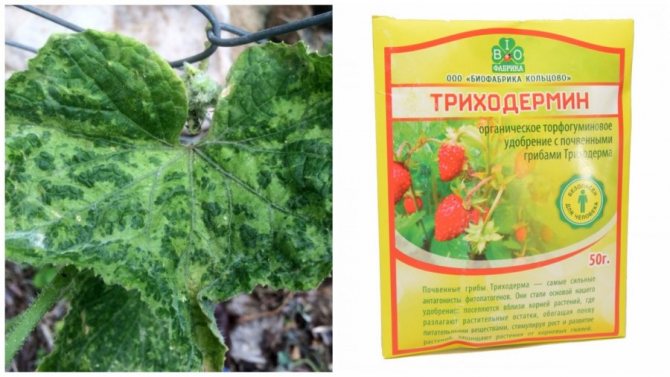

The drug is equally effective in the treatment of all types of vegetable, fruit and berry plants
Positive reviews
Svetlana, 46 years old I have my own garden where I grow fruit trees. For their processing, I have been using Trichodermin for more than one year. The drug is very good. It really works. The trees do not get sick, they bear fruit well. The quality of the crop is excellent. Personally, I'm happy. I process trees every month since spring. But there is one small problem - it is problematic to buy a product in Moscow. Not all stores have it. And his price, unlike other similar drugs, is much lower.
Yana, 29 years old She became interested in gardening a few years ago. The first year was a complete failure. Almost all the plants died, and there was practically no harvest. That year, a friend of mine advised me to use Trichodermin. She spoke in detail about how to properly dilute the solution and how to use it. There was so much harvest that we did not know what to do with it! The plants did not hurt, they grew well. This year I will definitely buy this product before planting seedlings. Plants grow much better with it!
Negative reviews
Olga, 37 years old I don’t know why people buy Trichodermin, but I personally used it several times and the result was, to put it mildly, unhappy. All this is deception and another divorce of suckers. Plants from it wither and die even faster. And the fruits become tasteless and do not ripen well.It is better to use other biological products, especially since their choice is rather big.
Precautions
Trichodermin is a substance of the 4th hazard class (little dangerous), but this is only because the 5th (not dangerous) means of agricultural chemistry is not assigned. The time of working with Trichodermin is not limited. However, it is better to work with the drug in plastic gloves, a petal respirator and ordinary goggles: getting on mucous membranes, it irritates them like any dust, and the range of individual sensitivity to biological products is very large. For the same reasons, after work, you need to wash your hands and face with soap; it is advisable to rinse in the shower. If the drug gets inside - take a glass of water with 2-3 powders of activated carbon, after a few minutes another 2-3 glasses of clean water, induce vomiting and consult a doctor.
Trichoderma veride instructions for use
Doses of the drug "Trichoderma Veride" for each culture are prescribed in the instructions for use. It is necessary to prepare the solution only before starting treatment. To do this, dilute the specified amount of the drug in a certain amount of water, always stirring, add so much water to end up with 10 liters of solution.
Important! The method of seed treatment is chosen depending on the disease that needs to be dealt with.
Treatment of seeds and planting material
When, at what stage, to use "Trichoderma veride", everyone decides individually, but experienced gardeners-gardeners recommend starting to influence the drug on future plants when they are still at the stage of seeds or seedlings. For this:
- On the eve of planting, place the seeds in a solution of the product (2%) for 5 minutes.
- Before being placed in open ground, seedlings are dipped with roots in a mash, consisting of earth and humus (2: 1), 5 g of the drug and 5 liters of water.
- Before starting sowing activities, apply a solution or powder of the drug directly into the wells or furrows.
Important! It is forbidden to make a solution of the drug based on chlorinated water.
Spraying plants
Plants are sprayed with a solution with "Trichoderma veride" as soon as two true leaves appear, and trichodermin, according to the manufacturer, will prevent the development of phytopathogens. Repeat the procedure every 14-21 days.
Plants need to be processed in the morning or after sunset, the weather should be dry and calm. The best option is when the rain has already passed, but it is still cloudy, and the temperature is 18 degrees and above.
The frequency of treatment can vary depending on the severity of the disease and can be up to 4-5 times every 7 days.
Watering with "Trichoderma veride"
It is possible to add "Trichoderma veride" for watering each garden crop at the rate of 100 ml per 10-15 liters or 30 g for the same amount of water. Proper use of the drug leads to an increase in yield by 20-30%.
Where to buy and how much does it cost?
The biological product can be bought in special stores that distribute planting material and care products. You can also do this at the representative firms, either by contacting in person or through the online store.
The average cost of a biological product in Ukraine is UAH 70 for 1 liter, in Russia the price is 330 rubles per liter.
To get the quick desired effect, you should definitely take into account all the features of the preparation of the solution and tank mixtures. Before use, study the instructions and follow all of its instructions.
Analogs
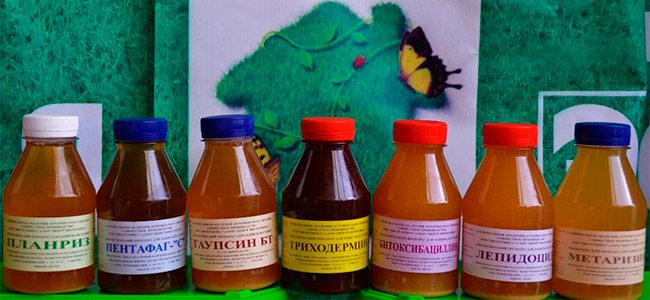

A biofungicide based on an antagonist fungus has several analogs, similar to it in composition and action on pathogens:
- Phytodoctor (based on hay stick);
- Fitosporin (hay stick);
- Riverm;
- Gaupsin;
- Planriz.
Each drug has its own specificity, effectiveness of action. When choosing, it is necessary to study the features, recommendations, instructions for use in order to get the maximum result.
According to the compatibility of the use of Trichodermin:
- it is impossible to prepare tank mixtures with preparations containing copper and mercury;
- use with solutions containing Metarizin spore strains is excluded.
Choosing Trichodermin or Fitisporin - which is better?
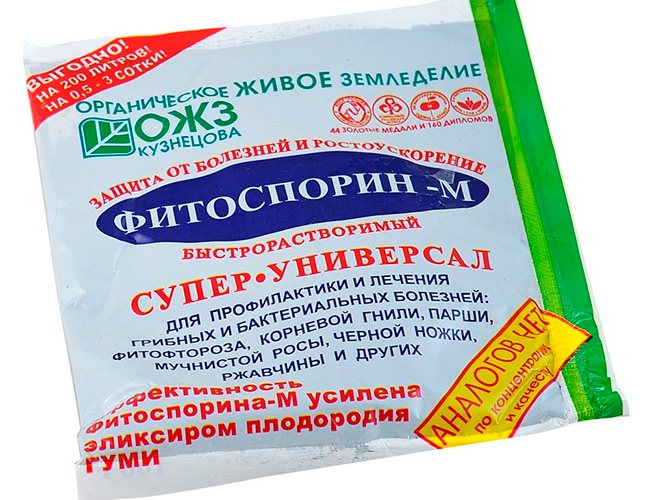

Trichodermin and Fitosporin are two well-known and popular biological preparations among gardeners. Both contribute to the suppression of reproduction, growth, development of dangerous pathogens, "work" due to fungal spores.
They differ in the following characteristics:
- spore strains (Trichodermin is a fungus of Trichoderma Lignorum, Fitosporin is a hay bacillus);
- speed of action (trichoderms act quickly, hay bacillus - slower, as they penetrate into cells and suppress pathogens from the inside);
- release form (Fitosporin is produced in the form of gels, paste, powder, liquid).
Like all biological products, both products cannot be used in combination with chemical-based pesticides and fungicides.
Advantages of Trichodermin
The biological product managed to become in demand among gardeners and gardeners due to a considerable list of advantages. It is worth noting the following advantages that the Trichodermin fertilizer possesses:
- The substances that make up it are completely safe for the health of people and animals. They are not toxic to plants and do not adversely affect pollinating insects.
- The product does not pollute the environment.
- Increases the yield of agricultural crops.
- Does not accumulate in roots, fruits and berries of plants that were grown in soil fertilized with a biological agent.
- Approved for use with fertilizers such as insecticides, pesticides and fungicides. Only its mixing with chemicals containing copper and mercury is not allowed.
- Equally effective in different types of soils.
- Retains a protective effect for a whole month after treatment.
The positive qualities of "Trichodermin" declared by the manufacturer were repeatedly noted in the reviews of gardeners who used the drug on their plots.
Biopreparation Trichodermin what is it, composition and purpose
Trichodermin is not some kind of creepy "chemistry", but a biological agent. It has a wide range of effects.
The drug can be used for:
- Prevention of the occurrence of diseases of various cultures and their treatment.
- Improvements to soil characteristics. Everyone knows that many infectious agents live in the ground. If the substrate is not treated, then the plants will hurt.
- Treatment of seeds before sowing, which increases the resistance of seedlings to infections.
- Spraying of horticultural crops (trees, shrubs).
- Acceleration of the process of decomposition of organic residues in the soil.
The main active ingredient of Trichodermina is a fungus called Trichoderma Lignorum in Latin. It is able to suppress the vital activity of harmful bacteria that settle in the soil, cause rot and other diseases of crops. The fungus competes with them, oppresses them, does not allow them to develop. In the course of its life, the Trichoderma fungus releases biologically active compounds into the soil that have a positive effect on plants.
In order for this useful fungus to develop normally, a barley substrate is included in the product. Also, the drug includes a complex of vitamins. They ensure good development and growth of crops, promote soil restoration, and activate the formation of roots.
The prepared solution must be used immediately, it cannot be saved - it quickly loses its properties. The drug itself can be stored for about 9 months, provided that it is not exposed to sunlight. Optimum temperature conditions +10 - +15 ° C.
How does a biological product work?
After processing the site with "Trichodermin", the following occurs:
- The fungus, which is part of the product, begins to multiply actively. In the course of its life, it releases a number of antibiotics, biologically active compounds and enzymes.
- The resulting substances have a detrimental effect on the reproduction processes of harmful microorganisms that are in the soil.
- The drug continues to release carbon, with which it breaks down organic matter into inorganic. They are converted into mobile compounds of elements such as potassium, nitrogen and phosphate.
- As a result of cleavage, the soil is enriched with useful minerals.
- The process of decay and nitrification begins.
- Further, cell sap is formed, which increases the immunity of the plant, accelerates its growth and development. As a result of this action, the seedling acquires resistance to diseases.
Application of "Trichodermina" launches the above processes. After a short period of time, positive changes become noticeable in the beds where vegetables, berry bushes and other plants that need fertilization grow.
- 1
Fertilizers for petunias - 2
Yellow leaves of tomatoes - 3
Aphid remedy - 4
Grape Fungicides
Application features
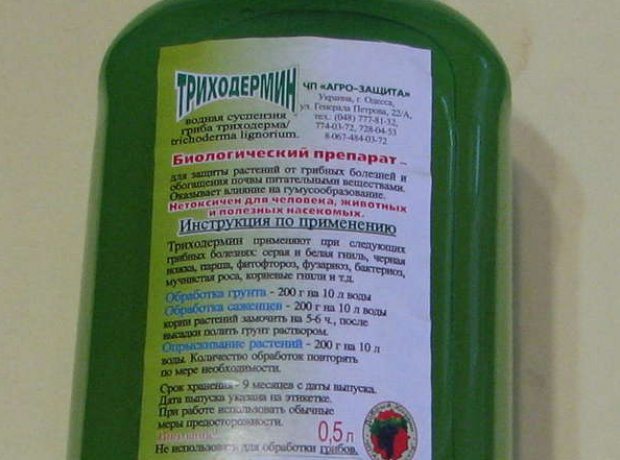

The instructions for the use of Trichodermina say that this agent has a beneficial effect on many garden crops at different stages of their development. It is often used to treat seeds and young seedlings before planting outdoors.
A biological product is also effective during the growing season of plants, since during this period of time they most of all need comprehensive protection against pathogens of fungal and infectious diseases.
Planned processing of vegetable crops
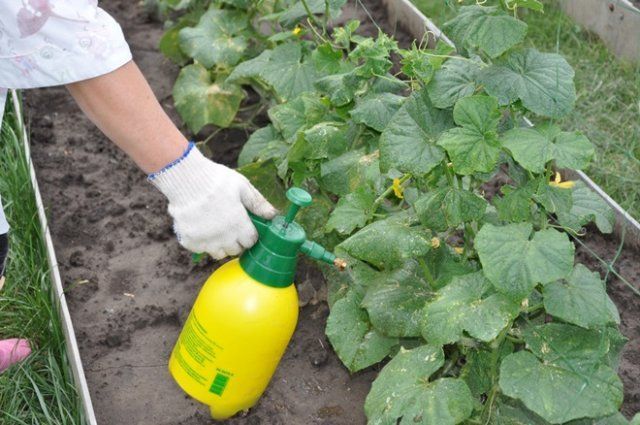

The insecticide helps protect cucumbers from anthracnose and white rot, tomatoes from late blight and macrosporiosis, and cabbage from black leg and phomosis. It is best used as a nutritional supplement.
To prepare it, you need to: dilute 100 ml of Trichodermin in a 10 l bucket of water. Plants can be treated with a working solution from the moment when a pair of real leaves appeared on them. This procedure can be carried out no more than once every 3 weeks.
It is advisable to spray vegetables after sunset or in cloudy weather. Such a procedure is considered especially effective after rain.
It is important to note that if the plant is badly damaged, then the number of treatments must be increased up to 5 times a week.
Spraying fruit and berry plants
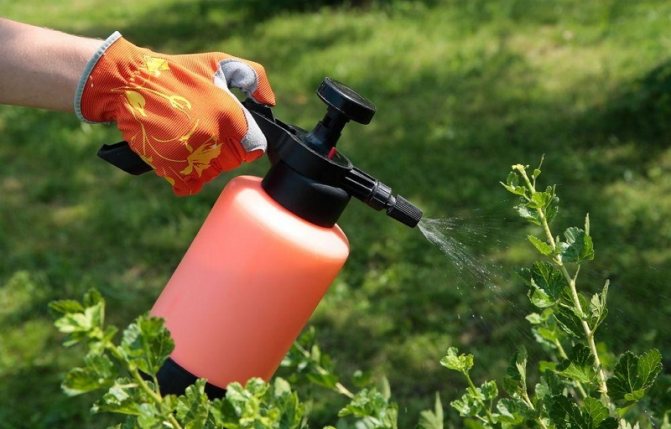

To protect strawberries, raspberries and gooseberry bushes from late blight, cytosporosis and gray rot, experienced summer residents are increasingly using an improved version of the biological product - Trichoderma verde.
The instructions for use indicate that this product can be used throughout the season. The first spraying should be carried out at a time when the buds begin to swell.
Trichoderma verde can be used to spray vineyards. For one hectare of the planted area, you need to take 3 liters of solution, which must be prepared from 10 liters of clean water and 80 ml of the product
It is important to remember that Trichoderma viride loses all its properties in water with a high chlorine content.
Processing potato tubers
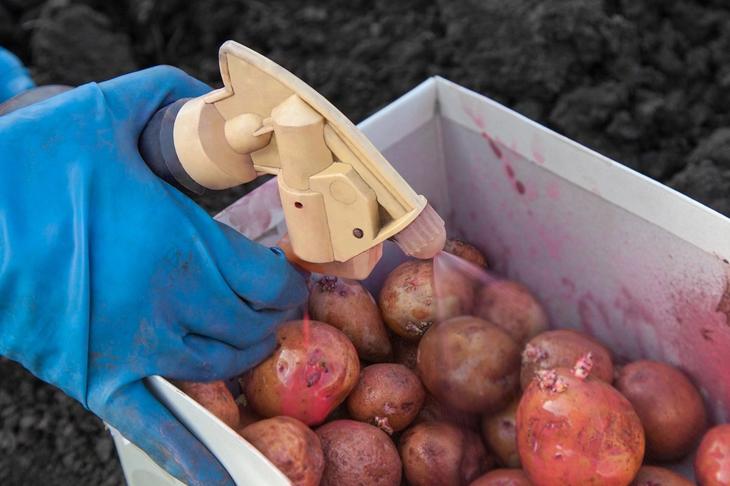

Thanks to the timely use of a biological agent, the root crop receives reliable protection against common scab, black leg and macrosporia.
Before planting in open ground, the potatoes are thoroughly treated with Trichodermin.
Instructions for use and reviews indicate that for 100 kg of potatoes it is necessary to prepare a working solution at the rate of 250 g of the drug for 10 liters of pure water. In the future, the root crop should be processed 3 more times.
Treatment
When the initial signs of infection appear, it is recommended to spray the plants without waiting for the development of the disease.
For vegetables and ornamental crops
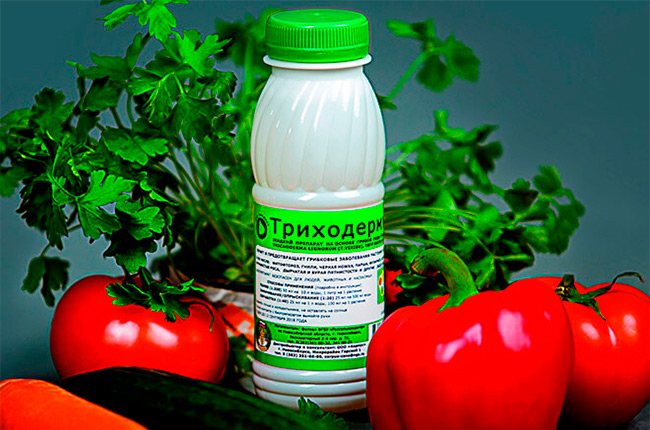

In the instructions for use, it is noted that the biological product gives reliable protection to tomatoes, cucumbers, cabbage. The spectrum of diseases is large:
- late blight;
- macrosporiosis;
- white rot;
- anthracnose;
- phomosis;
- blackleg;
- fusarium wilting.
Working solution - take dechlorinated water (10 liters), stir with 100 ml of biological agent. In case of severe infection, the number of procedures is up to 3 times a week.
Act
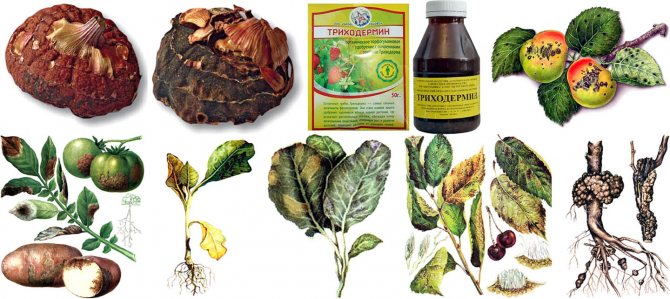

External signs of some plant diseases that Trichodermin helps against
Trichodermin is a complex preparation of protection, stimulation of plant growth, fertilization and soil formation. Its active substances are produced most of all by the germinating spores of the fungi Trichoderma sp. These are primarily antibiotics with a pronounced fungicidal effect: viridin, gliotoxin, satsukallin, trichodermin, etc. Therefore, Trichodermin is effective against more than 60 fungal and bacterial plant diseases, incl. such dangerous as (see also fig.):
- Alternaria
- Anthracnose
- Bacterial fruit cancer
- White and gray rot (phomoses)
- Keela cabbage
- Peach curl
- Powdery mildew (powdery mildew)
- Fruit scab
- Rhizoctonia
- Peronosporosis (mildew, downy mildew)
- Late blight of potatoes and tomatoes
- Fusarium
- Black leg of seedlings and other root rot
By releasing antibiotics, beneficial fungi suppress natural competitors - harmful antagonist fungi and pathogenic bacteria. Further, the fact that trichoderms have long and tightly made friends with higher plants comes into force: the latter supply the soil with organic residues (dead grass, dead leaves), and trichoderms prepare a nutritious substrate from them for themselves and their partners. In nature, germinated spores of the fungus begin to secrete enzymes that first promote the ammonization of organic amide nitrogen, i.e. cause non-pathogenic decay of organic residues. At the same time, their main nutrients (mainly phosphorus) meso- and microelements (calcium, etc.) are released into the forms assimilated by plants. Further, the growing hyphae of the fungus secrete already enzymes that nitrify ammonium nitrogen, i.e. transforming it into a form accessible to plants.
The nutrient medium is not all - the soil must be structured in order for plants to grow well. The primary formation of the soil structure is carried out by the roots of plants; in the immediate vicinity of them, favorable conditions are created for the development of useful soil microflora and microfauna. The environment saturated with their organic secretions attracts earthworms and other soil-forming macroorganisms.
Trichoderma participates in the formation of soil at all stages by releasing plant growth stimulants, mainly. root system. The lifespan of thin "hairy" nourishing plant roots is short. They die off, leaving air-permeable micro-passages in which the soil microfauna and microflora develop especially successfully. Thus, the action of trichoderma is clearly linked to the life cycle of partner plants: they are first provided with food for germination and the formation of strong roots, then for vegetative parts, and synchronously with the growth of plants, its stimulants for both.
Composition and varieties
The active substance is a substrate containing spores and other waste products of the soil fungus Trichoderma lignorum.
Includes:
- active substance - spores of the fungus Trichoderma;
- grain substrate (most often barley), which serves as the main environment from which the growth and development of the fungus begins;
- vitamin complex, which allows to activate the growth and development of mushroom crops;
Preparations functioning on this basis and according to the above principle are produced today in about a dozen varieties.
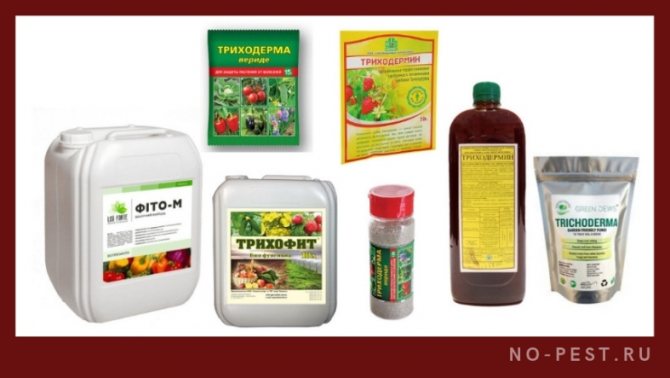

Examples of preparations based on the action of the fungus Trichoderma
The most famous and widely used today are as follows:
- "Trichodermin"
- "Trichoderma Veride"
- "Trichophyte"
- "Trichoflor"
- "Glyocladin"
- "FITO-M".
All of them have an equal effect, so the choice can be stopped at any of them. More often the choice is given to "Trichodermina", "Trichoderma Veride" and "Glyokladina".
The drugs are available either in powder form, or in tablet form, or in the form of an aqueous suspension.
The produced preparations are completely ready for use, but some gardeners believe that it is better to carry out preliminary preparation of bacteria for use, to make the so-called "uterine composition". The next video is about this.
How to propagate trichoderma at home
The instruction for growing trichoderma is quite simple, and even a novice summer resident is able to implement it.
- Rinse the pearl barley well until the water becomes clear.
- Soak in cold water for 8-12 hours (I put it overnight).
- Drain the water (let it drain well). It's good if you dab a little with a towel.
- Sterilize the jar in any way you like.
- Pour the beans into the jar and microwave them for 4-7 minutes (depending on power) for steaming. The grain should warm well, but not cook!
- Pour the industrial preparation of Trichoderma diluted according to the instructions into the cooled grain. For a half-liter jar, you need about 2 tablespoons.
- Do not seal the jar. Several layers of toilet paper or gauze, a notebook sheet for an elastic band.
- Place in a warm place.
Everything! After 1-2 days, you will see a white fluff on the grains - this is mycelium, after another 2-3 days sporulation will already be visible - bright green or bright yellow foci. Gradually, they will grow and cover the entire mycelium. At this stage, the preparation is ready.
If you did everything according to the instructions, but after two days you did not see the white mycelium fluff, it means that the industrial preparation that you used did not contain live spores - this is a fake, a violation of the production technology or a direct deception of the manufacturer. It makes no sense to wait longer than two days, because spores (if any) germinate very quickly under favorable conditions.
Compatibility
Trichodermin is compatible with any other biological products and incompatible with any pesticides and other pesticides. With the latter, incompatibility is one-sided, tk. they kill the spores of the fungus. That is, it is possible to apply toxic chemistry if the biological product does not help, in theory, immediately after it. But in the reverse order - a biological product not earlier than 2 weeks after the end of the protective action of the pesticide.
Self-compatibility
Of the species Trichoderma sp. in agricultural technology, the most active Trichoderma harzianum, Trichoderma lignorum and Trichoderma viride are used. The predominance of one or another species is determined by preim. the substrate on which the producing organism is cultivated (brown peat, straw, chaff, sawdust, animal organic waste). Foreign manufacturers and some domestic ones work according to the principle: "one drug - one type of Trichoderma", and give recommendations to use together with Trichodermin their other products with other types and strains of the fungus: Viridin, Gaupsin, Glyokladin, Pentafag, Planriz, Harvest, etc. increase in sales of products. However, most of the Trichodermin produced in Russia contains spores of all three types of fungus, and it makes no sense to supplement it with analogs. Although it does not hurt - Trichoderma Trichoderma is not an enemy.
What's better
Alas, there seems to be no answer to this question. Constant disputes about this among gardeners will continue. And really, how can you choose the best from two wonderful drugs? You can find good reviews about each, the principle of action is similar, they are safe for people and beneficial insects, they are cheap.
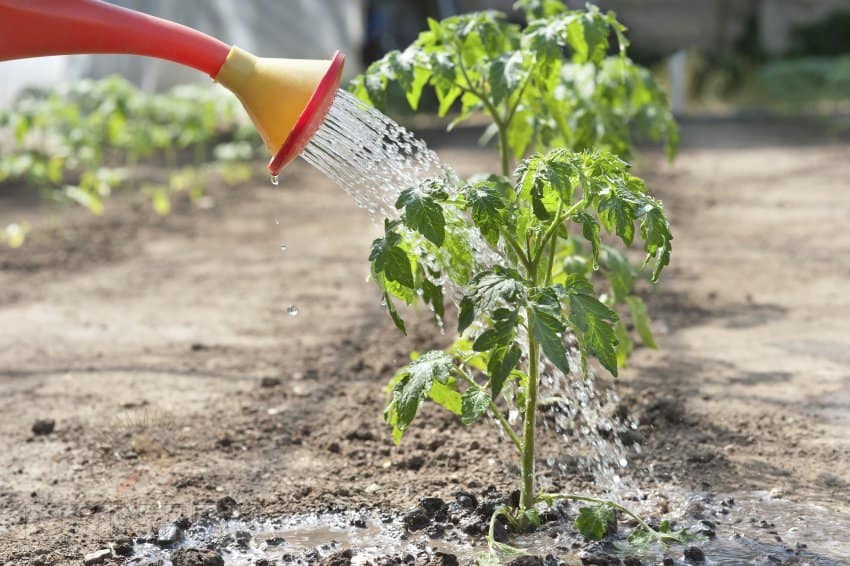

Their advantages can be enumerated endlessly. It is only clear that it is difficult to identify a clear winner. Therefore, when choosing between them, be guided by your personal preferences. You will not lose anything by choosing this or that drug.
Fitosporin
It is a biofungicide of systemic action. The active ingredient is hay bacillus soil bacteria. Once in plants, they begin to suppress the reproduction of pathogenic fungi and bacteria. The drug is not hazardous to humans or the environment.It can be used for plants in any phase of the growing season, disinfecting seeds and planting material.
In addition to Fitosporin "Universal", a separate one is produced - for potatoes with tomatoes, as well as FitosporinM "Reanimator" for flowers.
Any kind of preparation is remarkable for its long shelf life - almost 4 years. But the ready-made solution cannot be left for a long time, it should be used immediately.
Fitosporin is available both liquid and in the form of a pasty substrate, powder.
Dignity
- successfully defeats 25 diseases of fungal and bacterial origin (for example, late blight, powdery mildew, bacterial cancer, fusarium rot, etc.);
- the scope of its application is extensive - from the treatment of seeds and seedlings to the healing of grown plants;
- the ability to use the fungicide in any phase of the growing season;
- bacteria remain alive in a wide temperature range (from -50C to + 40C).
Fitosporin should be stored in shaded places, avoiding direct sunlight; spraying of plants should be carried out in cloudy weather or in the evening.
Areas of use
It is used for different purposes:
- improvement, rehabilitation of the soil, its structure and properties;
- acceleration of "maturation" of compost;
- preparation of seedlings and seeds;
- healing from diseases of adult plants.
For healing and improving the composition of the soil, the drug is used for spring or autumn digging (watering). During the growing season, plants are regularly sprayed, in order to prevent them, seeds, bulbs, corms, rhizomes are soaked just before planting. It is necessary to spray once every one and a half to two weeks - until the effect is achieved.
Watering:
- vegetables - once a month;
- berry and fruit - once a fortnight.
The drug is highly soluble in water. Do not use chlorinated water for solutions! Better - rain, spring, well, melt or boiled water. After diluting phytosporin, let the solution stand - so that the bacteria have time to wake up and activate.
For the powder (after dilution), two hours are enough; for pasta, you need to wait a few days (2-3); liquid immediately ready to use. To dilute the paste or powder of the preparation, you need water at room temperature. The dosage for different crops is indicated on the package.
Powder, paste or liquid preparation works the same way, however dosages differ, therefore it is so important to carefully read the instructions on the package.
Safety measures (overalls, gloves) should be observed.
In general, the action of Fitosporin is similar to that of Trichodermin.
Benefits
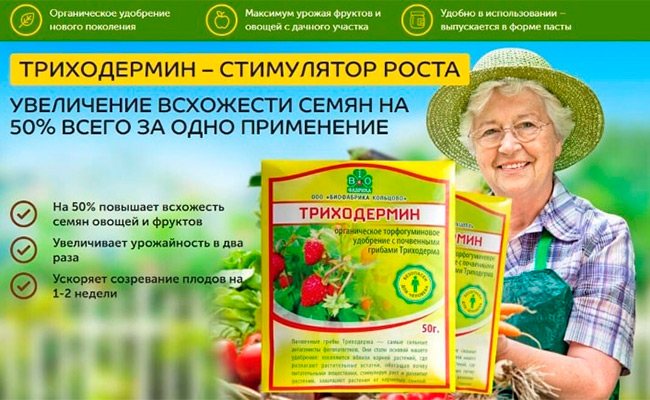

The choice of gardeners in favor of Trichodermin is explained by its merits. The most important thing is safety, both for human health and for the environment. Also among the "pluses":
- the ability to use on all types of soils;
- long plant protection time - up to 25-30 days;
- complex action (prevention, treatment);
- does not accumulate in the ground;
- contributes not only to a quantitative increase in harvesting indicators, but also to an improvement in the quality of vegetables, berries, fruits;
- compatible with other biological agents.
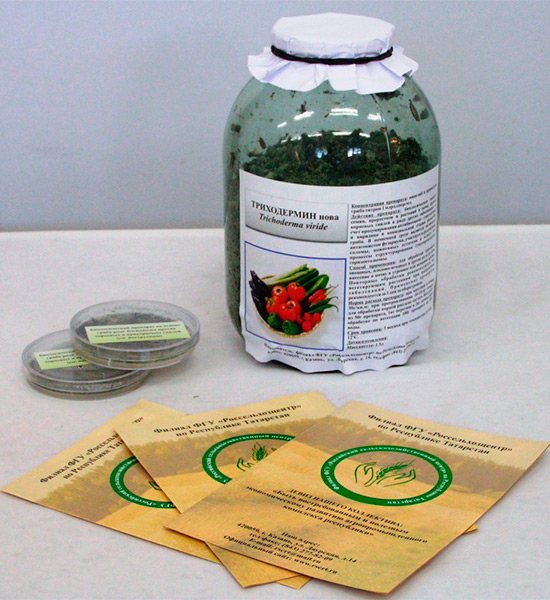

The time of working with it is not limited, however, it is required to comply with standard security measures. When to process plantings? Preventive spraying is recommended for the entire growing season, starting with the budding phase. In treatment, they are used according to symptoms.
Application in the garden
Trichodermin is used for most garden crops at all agronomic stages, starting with seed treatment, sowing, growing seedlings. It is used for plants during the growing season, to protect against diseases, increase immunity and enhance growth.
Seed and seedling treatment
The day before sowing, the seeds are soaked for 5 minutes in a 2% solution of the drug or coated with trichodermine powder.
To avoid root rot damage to root crops, onions, garlic, bulbous flowers, about 30 g of biologically active suspension is needed per 1 kg of bulbs or seeds.
Before transplanting, the roots of the seedlings are dipped in a chatterbox from a mixture of 2 parts of earth, 1 part of humus, 5 g of trichodermine and 5 liters of water.
When planting seedlings, sowing in open ground, 1-2% solution is applied directly to the well at the rate of 3-4 ml per plant, the powder is poured into the holes or sowing furrows to the depth of sowing seeds at the rate of 25-30 g / ²m.
Vegetables
For cucumbers, trichodermin is used as protection against root and white rot, ascochitiasis, anthracnose. For tomatoes from late blight, root rot, macrosporiosis, for cabbage - from black leg, phomosis.
Trichodermin is also used as an additive for watering any garden crops, diluting 100 ml of the drug in a bucket of water.
In order to prevent the plants, after the appearance of two true leaves, they are sprayed with a working solution once every 2-3 weeks.
Plants should be sprayed in cloudy weather or after sunset, preferably after rain, at temperatures not lower than + 18ºC.
In case of severe damage, the frequency of treatment can be increased up to 4-5 times a week.
Potatoes
Available in liquid and powder form.
Trichodermin helps to protect potato planting from black leg, macrosporiosis, phomosis, rhizoctonia, common scab.
Before planting, the seed is treated. For 100 kg of seed potatoes, 200 g of the product diluted in 10 liters of water is required.
Potatoes are processed at least three times per season: at emergence, during budding, after flowering.
Fruit and berry crops
Trichodermin for strawberries, raspberries is used to destroy fruit, gray rot, fight against spitophthora, cytosporosis, verticillosis. The berry is sprayed during the season from the beginning of the bud swelling.
For grapes, Trichodermine is used as a spray. The procedure is carried out during the swelling of the kidneys. For a hectare of vineyard, 2-3 liters of an aqueous suspension of 50 ml of the preparation and a bucket of water are enough.
Norms and schemes of use
The use of Trichodermin for plants is possible in three ways:
- For systematic soil reclamation (highly desirable - with organic fertilizing, see above);
- For the preparation of seed and planting material: seeds, tubers, bulbs, seedlings;
- For therapeutic and prophylactic seasonal treatments.
Maintaining and increasing fertility
To improve the quality of the soil, it is watered with a solution of 30 g (preferably ml) of Trichodermin in a bucket of water. If the soil is initially oversaturated with organic matter, poorly and / or improperly structured (these are physiologically lean soils - peat bogs, silty, alluvial - river alluvial, etc.), the dose of the drug in the first year is reduced by three times. Watering rate - 1.5 liters per 10 sq. m. the soil must be pre-moistened. The frequency is 10-15 days. Application time is the middle of a warm, cloudy day. The last watering is carried out after harvesting at a temperature not lower than +15 degrees - the mushrooms must be given time to fall asleep and dormant spores should be left on the trail. year. Since Trichodermin retains its fungicidal and bactericidal properties in the soil for up to a month, the frequency of watering is better tied to the weather - this way the drug will be more effective.
Note: for indoor plants, the dosage is 25 ml of liquid preparation per 1 liter of water. For orchids on landless substrates (peat, moss) - 5 ml per 1 liter of water. Watering rate - 50 ml per 1 liter of soil / substrate.
What about fruiting?
Saprophytic fungi “do not count” on the fruits of plants and therefore do not contribute to abundant fruiting, although they do not noticeably suppress it. Since the goal of agriculture is maximum fruiting (flowering for flowers), it is better to suspend watering with Trichodermin for the time from the beginning of budding to the formation of ovaries. Suddenly, separate foci of lesions appear on the plants, watering continues, but you need to reduce the dose of the drug by half.If the plants are healthy, it is best to stop it altogether before harvest. After it, until the average daily temperature drops to + (14-16), the application of the drug is resumed at full doses - this will give the plants the opportunity to better prepare for winter. The same instructions fully apply to treatment-and-prophylactic treatment (see below).
Seeds
The best way to prepare seeds with Trichodermin is to dust them. The seeds should not be pickled and absolutely healthy. If signs of rot, mold, etc. are noticeable on them, the seeds must be etched, and biological products for them should be discarded.
The consumption rate of Trichodermin powder for dusting seeds is 10 g for 3-4 glasses of material. Slightly moistened seeds are poured into a jar / bottle with a lid, pour the same dose of the drug there and shake the vessel until it looks like it clings to all the seeds. If a liquid preparation is used, prepare its 2% solution (20 ml per 1 liter of water) and soak the seeds in it for 5 minutes. The processed material is sown on the trail. day.
Tubers and bulbs
Sowing potato tubers and bulbs (including food crops) are soaked for 2-3 minutes in a Trichodermin solution on the eve of planting. For 50 kg of tubers (bag), prepare a solution of 100 ml of the drug in a half bucket of water. Sowing potatoes are soaked in portions.
For 1 kg of bulbs, incl. food crops. Dissolve 30 ml of liquid preparation in 1 water. The bulbs are also soaked in portions. If there are significantly more or less of them, the amount of ingredients can be proportionally changed, while maintaining a 3% concentration.
Seedling
Preventive treatment of seedlings with Trichodermin is carried out before and during planting in the ground. For primary processing, a chatterbox is prepared. composition:
- 2 glass of garden soil.
- 1 glass of humus.
- 5 g of powder preparation.
- Water - up to 5 liters.
The dry components are mixed in the specified sequence, stirring thoroughly, and mixed with water in small portions, also with stirring. Then the mixture is kept for an hour in a warm, dark place. Seedling roots are dipped in a chatterbox immediately before planting. If the material is planted individually in peat pots, 1-1.5 ml of the composition is released from a medical syringe into each of them, evenly distributing it over the surface of the soil.
When planting seedlings in the ground, Trichodermin solution is used 10 g / l for holes or 20 g / l when planting in furrows. The consumption rate is 3-4 ml per well or 25-30 ml per 1 m of the ridge. The drug is introduced into the soil (in the furrows - gradually, in the course of planting), bushes are planted and immediately wrapped in earth.
Prevention and treatment
Trichodermin will show all its advantages if pre-sowing treatment is combined with the current treatment-and-prophylactic treatment. Instructions for the complex use of Trichodermin are given in table. below. If the initial signs of diseases are noticed on individual plants, the treatment is not stopped during the period of flowering, ripening and harvesting (for bees, Trichodermin is not toxic and does not affect the quality of honey). At the same time, a slight drop in yield is possible without deteriorating the quality of the fruits, but if the pathogens are allowed to roam, it will be much worse. Consider only that on grapes and pathogen-sensitive berries (strawberries, raspberries), the use of the drug will be successful only if mildew, fruit rot, etc. "charms" do not rage with you. In the regions subject to them, you will have to alternate: year Bordeaux liquid, etc. - Biological products for 2-3 years.
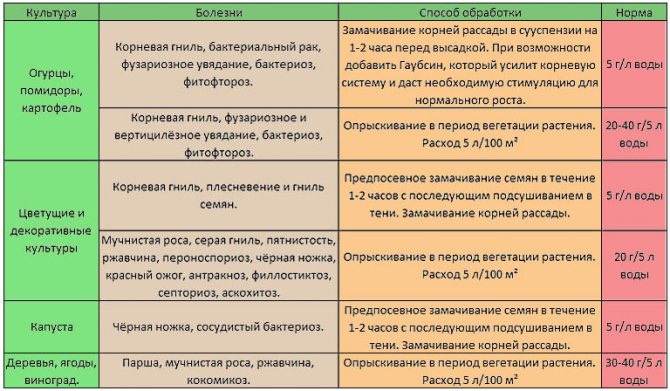

Rates and schemes for the use of Trichodermin for plants for therapeutic and prophylactic purposes
Application features
The use of Trichodermin on the site has a number of features essential for its effectiveness.
First, the drug is active at temperatures above +14 degrees. Mass awakening of spores in the soil within an hour is observed at temperatures above +18. Awakened spores remain active up to + (7-8) degrees, therefore, if the drug must be used in the spring, it must be applied to the soil well-warmed by the sun in the afternoon.
The second - Trichoderma in general does not care which plants to help. So on a neglected area overgrown with weeds, Trichodermin will give the opposite effect: the weeds "will break loose", and the cultivated plants will be even more oppressed.
Third, Trichodermin is almost exclusively a prophylactic agent. It will not cure plants from mass destruction by pathogens.And for prevention, the most effective introduction of the drug into the soil. Spraying with them can be carried out in the order of routine maintenance of the site with the sporadic appearance of the initial signs of diseases on the plants.
Application procedure
In connection with the above, the optimal procedure for the complete cultivation of a plot of virgin, fallow or waste land using Trichodermin is as follows:
If you got the plot in the spring, in the summer they regularly mow wild aboriginal plants on it, preventing flowering
Mowing is suitable for compost. In the case when the site got to you in the fall and the weeds managed to sow, it is permissible (with all the necessary precautions) to destroy them with a single (!) Application of Roundup. Dry tops are only and only burned! The area freed from weeds is plowed (dug up) and / or peeled before winter. If the aborigines on the site were healthy or did not have signs of mass destruction of diseases, the next year mineral pesticides are used according to preventive schemes and dosages: Bordeaux liquid, copper sulfate, fine sulfur, HOM (with a degree of damage transitional from sporadic to mass). If there were initially many sick people among the aborigines of the site, then
organic pesticides are used throughout the year. However, the use of such a dangerous agent as Fundazol should be avoided. The article on Fundazole briefly describes its analogues and substitutes. After another winter, they switch to the therapeutic and prophylactic use of Trichodermin together with other biological products (see at the end). In case of recurrence of mass or moderate morbidity, pesticides are used. In the future, a systematic preventive and therapeutic treatment with biological products is carried out annually; they refuse pesticide chemistry. In the event of a sudden outbreak of the disease (s), they again temporarily switch to pesticides, but for no more than 3-4 years and alternate the drugs year by year, in order to avoid the formation of a resistant population of pathogens.
When they are used
The main use of Trichodermin and Fitosporin begins during the period of plant disease. However, this is not the only reason to start using them. The drugs are used:
- When treating seeds before planting;
- Before placing seeds for storage;
- For disinfection and soil enrichment;
- For processing plant matter into organic fertilizers;
- For the care of vegetables as a nutritional supplement;
- For the prevention of diseases, both seedlings and adult plants.
You also need to remember that after rain, the film that forms on the plants after spraying is washed off partially or completely, so re-treatment is necessary.
Under normal conditions, plants should be treated with Fitosporin at intervals of 7-14 days. When using the drug during the watering period, it must be added once a month for vegetables and twice a month for fruit trees and shrubs.
For indoor plants, such watering is necessary once a month.
Trichodermin
Description
Antifungal agent for biological plant protection. It is able to withstand about sixty different diseases, here are some of them:
- Late blight;
- Fruit rot;
- Scab;
- Powdery mildew;
- Black leg and others.
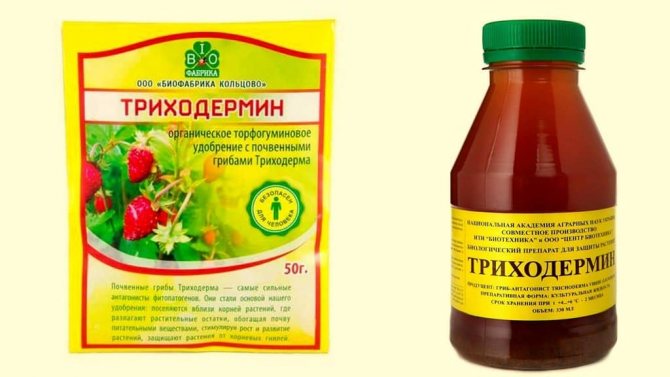

Structure
- Fungicide Trichoderma lignorum (Trichodermin) - the main component of the drug;
- Vitamins;
- Soil substrate is a medium for spores.
Price
The cost varies depending on the city. But on the Internet you can buy "Trichoderma viride" ten sachets of 15 grams for about 300 rubles.
Storage conditions
If the conditions are met, the product can be stored for up to nine months. Keep the drug in a cool (10-15 degrees Celsius) dark place.
Appointment
- Prevention and treatment of crops;
- Rehabilitation and enrichment of soil;
- Seed pickling;
- Spraying garden plants.
Operating principle
A mushroom called Trichoderma lignorum destroys dangerous microorganisms. Due to the chemical composition of their spores, the soil around the plant is significantly enriched with phosphorus and calcium. This stimulates the growth of crops. The trichodermin action algorithm is as follows:
- The fungus, which is the main component of the drug, begins to spread rapidly;
- During the life of Trichoderma lignorum, enzymes are released into the external environment, which has a detrimental effect on soil microorganisms;
- As a result of the release of carbon, the plantings are enriched with nitrogen, phosphorus and potassium. Nitrification processes begin, and the cell sap formed in plant tissues stimulates its resistance to diseases.


Appointment
The main purpose is the prevention and treatment of plant diseases and soil cultivation caused by fungal infections.
However, the drugs are universal, the scope of their application is extensive:
1. Prevention and treatment of diseases - late blight, coccomycosis, powdery mildew, gray and white rot, clusterosporium, leaf curl, scab, fruit rot, "Black leg" fusarium, ascochitosis and many others;
2. Improvement of useful microflora of the soil, its restoration after treatment with chemical preparations;
3. Treatment of seeds before planting in the ground;
4. Disinfection of soil before planting - processing of planting holes;
5. The drug can also be regarded as an organic fertilizer, since its side effect is the decomposition of chemical and organic compounds in the soil;
6. Use in cosmetology.
Storage and security measures
Storage of Trichodermin requires compliance with certain rules.
Trichodermin belongs to the group of environmentally friendly drugs, it is not dangerous for people, pollinating insects, animals, but still its storage and use requires compliance with the rules:
- Depending on the manufacturer, composition, release form (liquid or powder), the shelf life of trichodermin varies from 9 months to 5 years.
- The packaged preparation is stored in a cool place. The ready-made working solution at t + 4-6 ° C (lower shelf of the refrigerator) retains its properties for up to 2 months.
- When spraying, applying to the soil, processing seedlings and planting material, personal protective equipment is used: gloves, overalls.
- After the end of the procedure, hands and face are washed with soap under running water.
Forms of issue
Trichodermin is available as a dry powder and an aqueous suspension. Both preparations contain at least 9 billion live fungal spores in 1 g and 1 ml, respectively, i.e. in dosages, 1 ml of the suspension can be changed to 1 g of powder and set. Powdered Trichodermin is stored unpacked longer (up to 3 years, depending on the manufacturer); liquid is more convenient to work with.
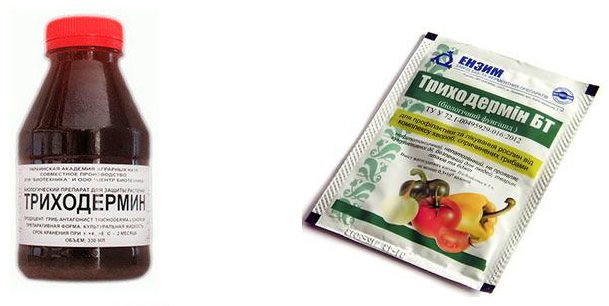

If instead of liquid Trichodermina dry is used, then before preparing the working solution, you need to prepare a mother liquor: 1 g of powder per half a glass of water, or a package of 10 g per 1 liter of water. The powder is slowly poured into warm water with continuous stirring. Then the mother liquor is left for 1-2 hours in a dark warm place (not lower than +15 Celsius) to wake up the spores, prepare a working solution and use it within 6 hours.
Note: Powdered Trichodermin is not stored in an opened package. Without moisture and nutrition, spores die when air is supplied. Not instantly, rather slowly, but it is impossible to predict the efficacy of a dry drug from an opened bag.
What diseases will Trichoderma help against?
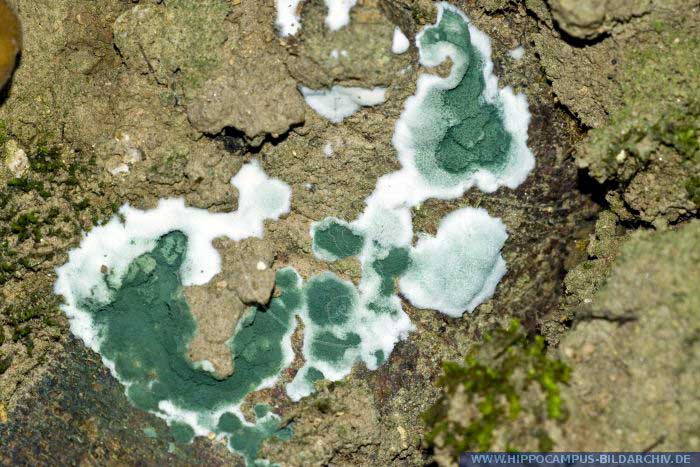

Trichoderma will help against late blight and other fungal diseases of plants. Photo: Hippocampus Bildarchiv
Trichodermu veride and analogues based on fungi of the genus Trichoderma will help rid plants in your country house of fungal diseases. Trichoderma destroys:
- alternaria;
- verticellous wilting;
- root and fruit rot;
- rhizoctonia;
- tracheomycosis;
- late blight;
- fusarium;
- black leg.
You should not wait until soil fungi grow on your site to forest proportions - in the forest saprophytes live in one place from year to year, no one digs up the soil, and they have not heard of chemicals, even more so. It is difficult to counteract pathogenic fungi if you are harassed all the time.
Therefore, in order to use all the advantages of saprophytic fungi, they came up with the idea of producing and selling to the population and organizations preparations containing spores and mycelium of fungi of the Trichoderma genus. The most common and easiest way to buy is Trichoderma Veride, which contains billions of spores of the fungus of the same name.
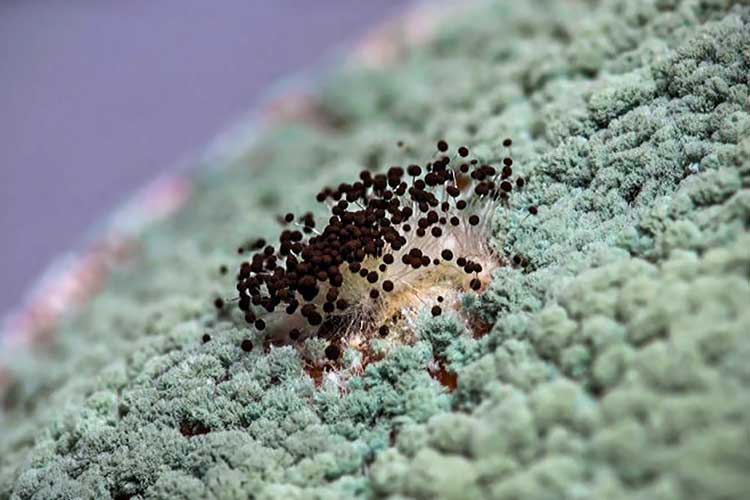

Spores of the fungus Trichoderma veride can be bought in the store, in the form of the drug of the same name
Trichoderma veride is a crystalline powder that dissolves in warm water. Typically, 10 liters of water requires 30 grams of the drug. The solution of the drug should be used during the day, pouring 150-200 ml of plants under the root into moist soil. Also, the working solution can be sprayed on plant leaves to prevent rot.
Most often, preparations based on the Trichoderma verde fungus and other fungi of the Trichoderma genus are used for:
- pre-sowing treatment (soaking and spraying) of seeds of potatoes, cucumbers, tomatoes, eggplants, peppers;
- watering cabbage plants at the root, to protect cabbage from diseases;
- processing of seedlings of all types of plants before planting, including the root system;
- spraying organic fertilizers before embedding in the soil when digging;
- disinfection of soil in the greenhouse in spring and autumn;
- watering holes and rows before planting potatoes;
- prevention and treatment of fungal diseases in indoor plants.
Thus, skillfully using preparations based on fungi of the Trichoderma genus, you can defeat fungal diseases of plants in the bud, using natural enemies, without the use of chemistry.
- Useful articles
- Garden
- Gardener
- Trichoderma veride: fungi from late blight and other diseases
Garden themes
Garden themes
New in the rubric
Seedlings of cucumbers: preparing seeds for planting Cabbage keel - a dangerous disease: prevention and control measures Eggplants in a greenhouse and open field: a gardener's guide July in a garden: tips for growing vegetables Onion storage: from A to Z
2012-2019 Good-Tips.PRO (+18)

